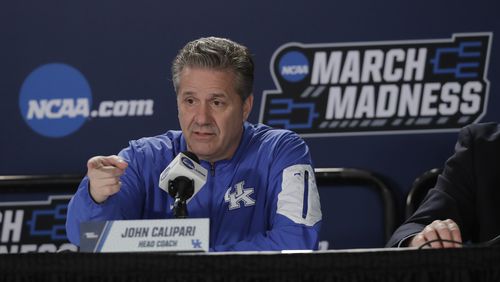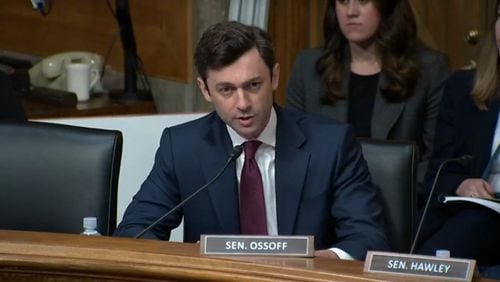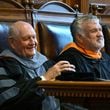He’s in the Naismith Hall of Fame. He makes $8 million per annum. He has taken three programs to the Final Four. (The first two appearances were vacated by NCAA sanctions, none implicating him.) He coaches at a place that has taken eight national championships. He is Goliath. As Wilt Chamberlain, who knew the sensation well, said: “Nobody roots for Goliath.”
Within the industry, John Calipari inspires no sympathy. (Jealousy, yes.) How can anyone feel sorry for the guy who has every advantage? So when the coach who perfected the art of the one-and-done – he didn’t actually invent it – complained about his latest Kentucky team being “too young,” it was laugh-out-loud funny. What, duh, did he expect?
But you dismiss Calipari at your peril. He has offered case studies in epic collapses – the final two minutes of regulation with Memphis in the 2008 championship game, Kentucky’s three consecutive shot-clock violations against Wisconsin in the 2015 Final Four – but he has also authored enough examples of actual coaching that we’re forced to wonder if he might, after all, know what he’s doing.
Five weeks after Kentucky appeared to be playing its way into the NIT, the Wildcats arrived at Philips Arena as massive favorites. Yes, the South is historically weakened: It’s the first regional in tournament annals to have lost its four top seeds this soon. Kentucky could make its way to San Antonio having beaten seeds No. 12, 13, 9 and either 7 or 11. But Kentucky, it must be said, is playing well enough that it might have risen to Final Four caliber if Virginia and Cincinnati and Tennessee had made it here.
“We needed to lose those four in a row,” Calipari said in St. Louis, just after his Wildcats won the SEC tournament, which they’d entered as the No. 4 seed, having gone 0-5 against the top three. They were then shipped to Boise as a No. 5 seed, with a date against Arizona surely awaiting in Round 2. They beat Davidson, which wasn’t a given, and then watched Arizona spit the bit against Buffalo. This quadrant of the Sweet 16 now includes Kansas State, Nevada and Loyola-Chicago.
You mightn’t have seen this coming, except that every so often Calipari reminds us that he’s not an empty chair. Something similar happened in 2011, the year after John Wall and DeMarcus Cousins exited; the next band of Wildcats were a No. 4 NCAA seed in a stacked East Regional that included North Carolina and Ohio State. Something similar happened in 2014, when the Wildcats entered the Big Dance as a No. 8 seed in the same Midwest as undefeated Wichita State. Both those Kentucky teams had been dismissed as substandard. Both wound up in the Final Four.
Say what you will about Calipari, but he can rally a young team – granted, he never has anything but a young team – as well as anybody in the business. He can instill in guys who won’t be teammates for more than six months a sense of selflessness. There’s never a ball hog on a Calipari team, which is remarkable given that nearly all are McDonald’s All-Americans. He can come across as a gasbag, a whiner and sometimes as an out-and-out phony. But he’s pretty good in March.
He has, you know, been here before. Few of his players have. (Again, that’s by one-and-done design.) On Wednesday, these were Calipari’s opening remarks: “My challenge is making sure my kids don’t drink that poison. That poison is that we have an easy road.”
Asked if he ever seeks to bring a team down in the effort to build it back up in time for the Dance, he said: “I never take it down. I’m always trying to coach my teams to win games. What ends up happening with the teams you were talking about (2011, 2014, now) is that we were just so young it took time. You’re trying to land the team before you run out of runway.”
Then: “In 2014, the nose of plane hit the fence. We got better, and it kind of clicked in the tournament, … But ’11, (point guard) Brandon Knight missed six game-winners (in the regular season). Then he started making game-winners.”
Then: “This team is totally different. This is team is even more inexperienced.”
That’s true. The 2011 Wildcats had Darius Miller, DeAndre Liggins and Josh Harrellson, all upperclassmen. The 2014 team had no contributing junior or senior, but it had influential sophomores Willie Cauley-Stein and Alex Poythress. This team starts five freshmen. Of its top eight scorers, seven are freshmen.
The nadir came in February. Kentucky played Missouri, Tennessee, Texas A&M and Auburn – “four NCAA teams, three on the road,” Calipari noted. The Wildcats lost all four. They’ve won nine of 10 since.
Guard Hamadou Diallo: “When we lost four in a row, we knew many people counted us out and turned against us.”
Point guard Shai Gilgeous-Alexander: “If we don’t lose those four games, I don’t think we’re as good as we are now.”
This isn’t the best Kentucky team of Calipari’s nine years in Lexington. It might rank sixth or seventh. But the clouds have parted for these Wildcats, improbably the team to beat. “It’s definitely a lot of weight on our shoulders,” Diallo said.
Then again, this is Kentucky, which is always expected to win every game, and is -- stop me if you’ve heard this before -- massively gifted. It should be able to negotiate the least imposing regional ever. Should, I said.
About the Author







